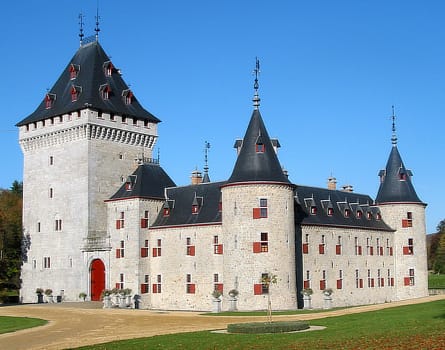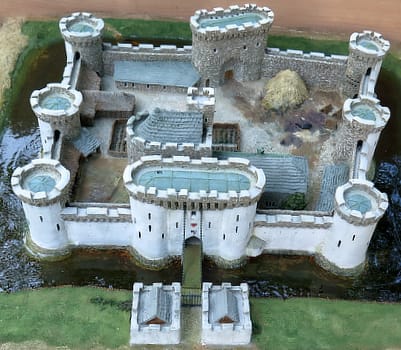>> | Home | Books | Visit | Explore & More | Events | FAQs | Contacts
Hemyock Castle
Ancient Heart of the Blackdowns
Did the Slighting of Hemyock Castle Make England Safer?
(a work in progress)
The best historical discoveries at first shock… then seem obvious… then lead further…
Most English castles are ruined. But is this because peace meant that they were no longer needed… or was there a conscious decision to destroy private fortifications in order to make England more peaceful and tolerant?
ie. Were these ruined castles the effect… or the cause of peace?
Tale of Two Towers: Hemyock Castle, England & Jemeppe Castle, Belgium

Jemeppe Castle, Hargimont, Belgium
Image Credit: Jean-Pol GRANDMONT
- Built on an older site
- 14th century large stone donjon defensive tower
- Occupied by Ochain family until 1616, during frequent periods of unrest
- Greatly extended and re-fortified by Raes d'Ans during 17th century
- Modernised during 18th & 19th centuries
- Converted into luxury hotel & centre in 20th century
- Region endured centuries of unrest and war

Hemyock Castle, Devon
- Built on an older site
- 14th century castle, encircling an older fortified manor house
- Occupied briefly by Asthorpes until their deaths (without heirs) in 1399
- Probably then largely unused as an active castle
- Garrisoned for Parliament during 17th century English Civil War
- Besieged twice & then captured by Royalists
- Slighted (destroyed), probably during 1660s
- Ruins converted into a tenant farm, then into a private house
- Region largely peaceful since 17th century
I'd assumed that England's ruined castles had been destroyed in battles, or simply had become obsolete. But while browsing some 17th century State Papers at Kew – as one does – I was startled by this quote from the English Civil War period, by Sir John Meldrum, to the Committee of both Kingdoms, 2 Nov 1644, Liverpool:
"France, Italy, and the Low countries have found by experience during these last three hundred years what losses are entailed by places being fortified, while the subjects of the isle of Britain, through absence thereof, have lived in more tranquillity. If Gainsborough [town fortifications] had not been razed by my order, the enemy might have found a nest to have hatched much mischief at this time. Reading [town] might have produced the same effect if the fortifications had not been demolished…"
Like many professional soldiers who took part in England's Civil Wars, Sir John Meldrum was a veteran of many years fighting in endless Continental wars.
Like many leaders in England's new "commonwealth" regime after the ousting of King Charles I, he was keen to rebuild England into a "new Jerusalem," a new utopia. This quote is an example from the intense debates during that period, about the future structure and government of England. Debates continued for decades, beyond the "restoration" of King Charles II. Many themes are still relevant to our modern lives.
Unlike in some Continental countries, most English castles are ruined; most large houses are not fortified. Increasingly, the English State has banned private fortifications – as was proposed by Sir John Meldrum – together with private armies, and the possession or carrying of weapons; except where highly regulated.
- Could these political decisions have made England largely more peaceable and tolerant?
- So, did the slighting of Hemyock Castle make England safer?
- But, do recent trends risk reversing this progress?
Throughout history, trouble has come from powerful "war lords," "barons," and others who have a force of henchmen. There has always been tension between "rulers" and "ruled"; and particularly around powerful "elites."
Rulers often struggle to control powerful groups; powerful groups fight against each other; powerful groups try to control rulers. For example, a group of powerful barons imposed the 1215 Magna Carta to reduce the powers of King John and all subsequent monarchs.
In 1399, a group of barons deposed and then murdered King Richard II. (Both of the Asthorpes also died in 1399.)
All monarchs needed money, to run the state, to wage wars, and to fund their household. One way to control the monarch was to limit his access to money: Several monarchs had to raise money by "pawning" the crown jewels with money-lenders. Nobles also borrowed money. Hence, money-lenders – often Jews, because medieval "usury" rules forbade Christians and others from lending money – were a frequent target. (See the paragraphs about debts in the Magna Carta.)
Monarchs had the valuable power of patronage, so could reward supporters. This made the ability to control access to the monarch a vital issue; one which helped to trigger the Wars of the Roses (1455 – 1487), between supporters of two rival royal lines: York and Lancaster.
Controls on Land Holdings, Fortifications and Private Armies
Whenever a "war lord" had access to a safe refuge, wealth, and control of a private army, they were a threat to the state and to peace.
After 1066, to prevent his nobles becoming dangerous regional powers, William the Conqueror deliberately gave them land holdings which were split into small, separate parcels, spread around England.
No-one was allowed to build a fortification, without a "licence to crenellate" granted by their lord: As their lord, King Richard II himself granted the trusted Asthorpes the licence to crenellate Hemyock Castle in 1380; to help impose his will against rebellious Devon lords.
During feudal times, vassals were obliged to render military service to their lord, in return for land. The great lords were obliged to render service to the monarch. In turn, lords were obliged to support and champion their vassals, including in legal disputes… even (especially) when their vassals had broken the law. So lords were able to command the support of large numbers of loyal henchmen who depended on them.
But from the reign of Stephen, and then particularly during the reign of King Edward III and the Hundred Years War with France (1337 – 1453), instead of lords granting land to their warriors, as in the old Feudal System, increasingly lords instead paid warriors to provide military service to a lord: The new system of "Livery" "Maintenance" and "Fee'd" men.
So as well as the danger from lords commanding large numbers of henchmen; many of these military men were released from the lords' service when they were no longer needed: Rootless roaming bands of unemployed soldiers became a new danger, both at home and on the Continent.
For centuries, there were extraordinary incidents where lords used their private armies to settle legal disputes over land, and widespread corruption eg. where the judge in a legal case could well be a "liveried" servant of the accused (or of the accused's lord).
After yet more trouble from powerful barons, King Richard II tried to regulate the private "liveried" armies of lords, in the 1390 Statute of Livery.
There were many further attempts to regulate the worst lawless excesses and distortions of England's justice system by these powerful groups, including in 1401, 1406, 1411, 1414, 1429, and 1468. But these were largely ineffective.
During the tumultuous Tudor times, King Henry VII enacted the 1504 Statute of Liveries which outlawed the retention of liveries or indentured men, except in the lord's personal household.
However, the problem eventually solved itself: Later in the Tudor period, these men found new opportunities in commerce and maritime enterprises, including in the war with Spain and in the opening up of the New World. Some became adventurers, buccaneers, privateers or mariner-pirates. Similarly, wealthy lords found new opportunities for using their money and power. But the potential dangers continued.
This was what people like Sir John Meldrum were hoping to resolve, by banning all private fortifications which were not under the control of the state.
In subsequent centuries, people were banned from having military weapons or unauthorised military training. Later, people were also forbidden from carrying or possessing personal weapons.
In return, the English state undertook to keep people safe, notably through a reliable justice system and police force.
The egalitarian era also promoted openness and because influential people experienced daily life that was more similar to that of ordinary people, they were more likely to introduce laws which made life safer and more peaceful for everyone.
However, temptations are always there: In more recent years – partly as a result of terrorist threats – influential people have increasingly bought (or been provided with) extra protections and defences. So the experiences and lives of influential people have become different to those of ordinary people. "They" are kept safe (often at public expense) and are allowed to breeze through the everyday security restrictions inflicted on ordinary people, so there is less pressure on these influential people to resolve the problems "we" experience in everyday life.
This has led to the state breaking its promise to keep ordinary people safe. More ordinary people are now fearful enough to pay for their own security measures: Home CCTV, high walls & electric gates, blacked-out windows in cars, even private police patrols. Although illegal, some people (especially some young people) now carry weapons for self-protection.
Also, some new groups and criminal groups have established virtual "no-go" tower-blocks of flats (apartment buildings), streets & areas of cities. Gangs – often wearing distinctive clothing (rather like the idea of medieval livery badges) – "protect" their territories and sources of revenue (usually criminal), sometimes raiding opposing groups and competitors.
So, do we need a new Sir John Meldrum to restore order and peace?
Home | Books | Visit | Explore & More | Events | FAQs | Contacts
Hemyock Castle, Hemyock, CULLOMPTON, Devon, EX15 3RJ, UK.
© 2001–2023. Prepared and published by Curlew Communications Ltd